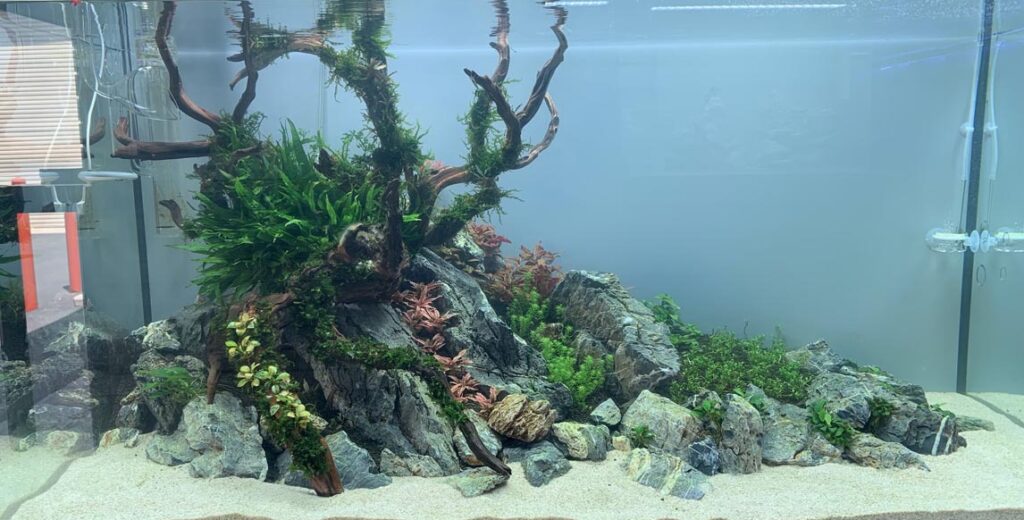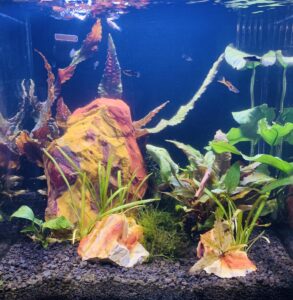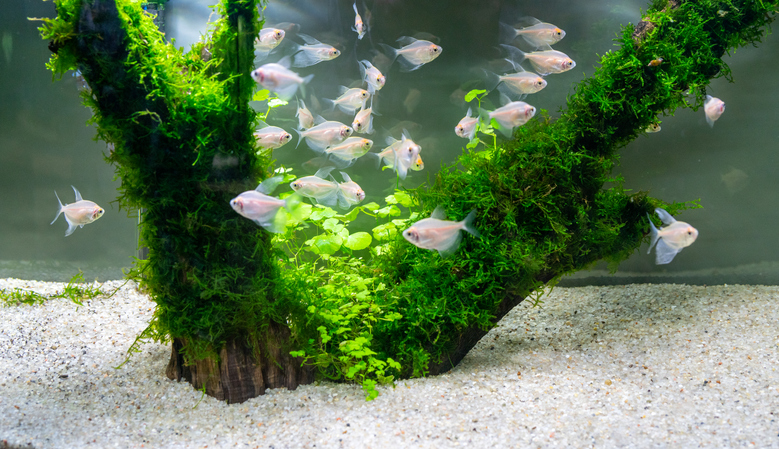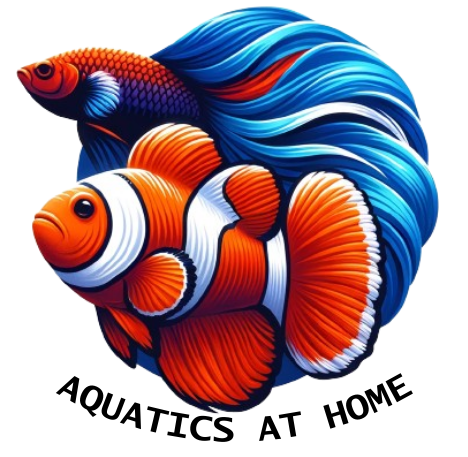Once you have graduated from multicolor rocks and trying to recreate Spongebob’s neighborhood in your aquarium, you may start to consider live plants in your tank.
Adding live plants to your aquarium can benefit your fish and other aquatic creatures. For one thing – plastic plants may look good to us, but they are no replacement for the real thing.
Starting with freshwater plants for a novice aquarist is an excellent way to get started with building a natural ecosystem. This article will explore the benefits of live plants, types of freshwater plants, and top plants for beginners.
Why Choose Freshwater Plants for Your Aquarium
If you’re looking to create a stunning and healthy aquarium, adding freshwater plants is an excellent choice. If you go to any local fish store, you will see some truly amazing planted tanks. If you are new to the hobby – trust me, take baby steps. Not all plants are easy to care for – on one hand there are some plants like the beautiful but dreaded duckweed plant that will grow everywhere… but others, like rotala macrandra, require extensive supplementing and active care to maintain.
That doesn’t mean you can’t grow a beautiful planted aquarium with little or even no experience.
Benefits of Live Plants
Live plants in your aquarium have several benefits, including improving water quality and adding oxygen to the water. Plants are natural filters, removing harmful organic waste and chemicals such as nitrates and phosphates that can build up in your tank. Plants also help to keep a stable pH in the water and reduce the frequency of water changes needed.

But that’s not all. Live plants also provide a natural hiding place for your fish, reducing stress and promoting a healthy environment for them to thrive in. Ever had baby fish? Those little fry are like… well.. french fries to many adult fish. Well those babies love these hiding places.
They also help to reduce algae growth by competing for nutrients and blocking out excess light.
Creating a Natural Ecosystem
One of the biggest and most common reasons you might want to add plants to your aquarium is to create a more natural ecosystem.
I don’t know what happened to me, but at some point I lost my sense of whimsy and now really dislike fake things in fish tanks. I think it would be like coming into someone’s home and seeing a fake plastic couch and a bookcase full of fake books. Quite frankly, I’m just a much bigger fan of the real thing. If you do, however, find a way to incorporate plant life with some whimsical fake elements, I take my hat off to you. It’s just not for me.
Plants provide a habitat for your aquatic creatures and create a natural food source for herbivores. Having a balanced ecosystem benefits the health and well-being of your fish and other creatures, which helps to reduce stress and disease.
Plus, a natural ecosystem is a joy to watch. Seeing your fish interact with their environment and watching the plants grow and change adds a new level of enjoyment to your aquarium hobby. Being in nature has been shown to lower cortisol levels, reduce heart rate, and improve overall mood and well-being – and having a fish tank with some great plants is like taking a slice of nature and putting it in your own home.

Fun fact: Doctors sometimes recommend fish tanks as a way to reduce stress because they provide a soothing and peaceful atmosphere. Watching fish swim can amid a sea of plants can help to lower blood pressure and reduce feelings of anxiety, providing a natural form of relaxation and stress relief.
Aesthetics and Personalization
Adding live plants to your aquarium adds a beautiful aesthetic and allows for personalization of your aquascape. Plants come in all sorts of colors and textures, and you can choose the type of plants that best suit your desired look and feel for your tank. I’m a big fan of greens, reds, and browns, but that’s just my own style.
Plants add depth and interest to your aquarium and can act as a focal point for your decorating scheme. There are even fish tanks that serve as art installments for their natural beauty.
But it’s not just about looks. Adding live plants can also provide a natural environment for your fish, which will make them feel more at home and reduce stress. Plus, watching your fish interact with their surroundings is a fascinating experience that can be enjoyed for as long as you have the aquarium.
You should be able to find a wide variety of plants to match your personal interests and aquarium inhabitant community compatibility. If you make sure everything is compatible with both your taste and the inhabitants’ needs, you will end up with something far better than plastic plants.
Types of Freshwater Plants for Starter Aquariums
Starting an aquarium can be an exciting adventure, but it can also be daunting when it comes to choosing the right plants. The right plants can make all the difference in creating a healthy and beautiful environment for your fish. In this article, we’ll go over a few types of plants to help you select what’s right for you.
Floating Plants
Floating plants are a welcome addition to just about any aquarium, especially for beginners. They require little maintenance and are easy to propagate. These plants float on the surface of the water and provide shade for your fish, which can be beneficial for their health. They also help to reduce algal growth in the aquarium by absorbing excess nutrients from the water. Two common types of floating plants are Amazon Frogbit and Water Lettuce.
Amazon Frogbit is a small, round plant with green leaves that resemble lily pads. It is easy to care for and propagates quickly. The roots of Amazon frogbit are long and look pretty cool under strong lighting too. If the frogbit is left to grow on it’s own, it can cover the entire surface of your tank.
Another plant, duckweed, also known as Lemna minor, is a small, fast-growing floating freshwater plant that thrives in aquariums. Its bright green leaves can form dense mats on the water’s surface if left unchecked, providing shelter and shade for fish and other aquatic life. Duckweed effectively absorbs excess nutrients, such as nitrates and phosphates, from the water, helping to maintain water quality and prevent algal blooms. Additionally, it serves as a natural food source for some fish and invertebrates, promoting a balanced and healthy ecosystem within the aquarium.
Rooted Plants
Rooted plants are perfect for beginners and serve as a foundation for your aquascape. These plants attach to rocks and driftwood and can grow slowly, making them easy to care for. Anubias and Java Ferns are two popular types of rooted plants for aquariums.
Anubias is a hardy plant that can grow in a variety of conditions. It attaches to rocks and driftwood and can grow slowly, making it perfect for beginners. You will often find this little plant sold in a small plastic pot or even pre-attached to a piece of driftwood.
Java Fern is another popular choice for aquariums. It has long, narrow leaves and can attach to rocks and driftwood. It is also easy to care for and can grow in a variety of conditions. I have even had some success using java ferns in potted ponds.
Stem Plants
Stem plants are fast-growing and help to quickly establish a natural environment in your aquarium. They are perfect for hiding aquarium equipment, providing areas for fish to hide, and adding a pop of color to your tank. Hornwort and Water Wisteria are two common types of stem plants.
Hornwort is a fast-growing plant that can grow up to 10 inches per week. It has long, green stems and can provide ample hiding places for fish. It can also act as a freefloating plant. Compared to other strong leafy varieties, the narrow leaves on a hornwort plant can break up the scenery with something a little different in shape.
Water Wisteria is another popular choice for aquariums. It has long, narrow leaves and can grow up to 20 inches tall. It is also easy to propagate, making it a great choice for beginners. This plant is often sold in bunches and ranks pretty high on the hardiness scale. Use this plant toward the back of your tank if your tank is less than two feet deep.
Carpeting Plants
Carpeting plants create a lush, green carpet over the bottom of your aquarium. They require high light and nutrient levels to thrive and can be challenging to maintain. However, they add a beautiful aesthetic to your tank and create a natural habitat for fish and invertebrates. Two popular types of carpeting plants are Dwarf Hairgrass and Monte Carlo.
Dwarf Hairgrass is a small, grass-like plant that can grow up to 4 inches tall. It requires high light and nutrient levels to thrive, but it can create a beautiful carpet in your aquarium. People who like this plant may also fancy a well-manicured lawn. If you are working toward a more artistic planted aesthetic, you may find this plant very useful in creating space while also providing a lot of coverage to your aquarium floor.
Monte Carlo is another popular choice for carpeting plants. It has small, round leaves and can create a thick carpet in your aquarium. It requires high light and nutrient levels (CO2 among other things), but it can create a stunning visual effect in your tank. If you are up for the challenge, this is certainly one plant you might want to consider.
Regardless of if you choose floating plants, rooted plants, stem plants, or carpeting plants, adding plants to your aquarium can create a healthy and beautiful environment for your fish.
Top Freshwater Plants for Beginners
If you just starting your journey in the aquarium hobby and are looking to add some greenery to your underwater landscape, you’re in luck! There are plenty of freshwater plants that are perfect for beginners. Not only do they add aesthetic appeal to your tank, but they also provide a natural environment for your fish and other aquatic creatures. Here are some top picks for easy-to-care-for freshwater plants:
Java Moss
Java Moss is an excellent starter plant for novices due to its undemanding nature. This plant is versatile and can attach to most surfaces in your aquarium, including rocks, driftwood, and even gravel.
It serves as a natural habitat for shrimp and fry and provides a hiding place for fish. Java Moss is also a great plant for breeding fish, as it provides a safe place for eggs to hatch and fry to grow.
I really like attaching java moss to branches of driftwood to make underwater trees. If used right, you can get a really neat effect!
Anubias
Anubias is another easy-to-care-for plant and requires little maintenance. This plant attaches to rocks and driftwood and requires low light levels, making it a great choice for beginners who may not have a lot of experience with aquarium lighting. Anubias come in many varieties and are an excellent choice for a beginner aquarist looking to add some variety to their tank.
Amazon Sword
The Amazon Sword is a popular freshwater plant and serves as a focal point in your aquarium. This plant requires moderate light and fertilizer and needs to be anchored in the substrate. The Amazon Sword is fast-growing and quickly establishes a natural environment in your tank. It also provides a natural hiding place for fish and other aquatic creatures.
Water Wisteria
Water Wisteria is a hardy plant and grows easily in low-light environments. This plant is versatile and can float on the water’s surface or be rooted in the substrate. Water Wisteria is an excellent choice for beginners and provides many benefits for your aquarium. It helps to oxygenate the water, removes harmful toxins, and provides a natural habitat for fish and other aquatic creatures.
Cryptocoryne
Cryptocoryne is an easy-to-care-for plant that thrives in low-light environments. This plant requires a nutrient-rich substrate and provides a natural habitat for fish and invertebrates.
Cryptocoryne comes in many varieties and can add color variety to your aquarium since it comes in a few different colors. It is also known for its ability to remove harmful toxins from the water, making it a great choice for beginners looking to maintain a healthy and natural environment for their aquatic pets.
With these easy-to-care-for options, even newbies can enjoy the benefits of a planted aquarium.
Planting and Maintenance Tips
Having a beautiful and thriving aquarium requires more than just adding water and fish. Proper planting and maintenance are crucial to creating a healthy and vibrant aquatic environment. Here are some additional tips to help your plants flourish.

Choosing the Right Substrate
There are many great substrate options to choose from when picking out what to put in your aquarium. I always like to talk to my LFS professionals about what substrate works best for each plant, then I carve out sections with each type of substrate if I need a couple different options to work with.
Some popular choices include gravel, sand, and soil. It is important to choose a substrate that is appropriate for the type of plants you have.
For example, plants that require a lot of nutrients may benefit from a nutrient-rich soil substrate. Additionally, adding fertilizers to your substrate can help to enhance the growth of your plants.
Providing Adequate Lighting
Lighting is a critical component of plant growth. The right lighting can help your plants thrive, while inadequate lighting can cause them to wither and die.
When selecting lighting for your aquarium, consider the type of plants you have and their specific lighting requirements. Freshwater plants thrive on a very different spectrum of light than salt water tanks, so please don’t make the mistake of throwing marine light on a freshwater aquarium.
Some plants require high levels of light, while others prefer a low-light environment. Be sure to choose the correct lighting for your plant’s needs to help them grow and flourish.
Fertilization and Nutrient Requirements
Plants require specific nutrients to grow and thrive. In addition to selecting the right substrate and lighting, it is important to provide your plants with the nutrients they need. Adding a nutrient supplement to your aquarium can help to enhance plant growth. Be sure to research your plant’s specific nutrient needs to provide them with the nutrients they require. The right nutrients will make or break the growth quality and speed of the plants in your tank.
Pruning and Trimming
Regular pruning and trimming are essential to the health and growth of your plants. Removing dead or yellow leaves can help to prevent the spread of disease and promote healthy growth. Additionally, trimming your plants can help to control their size and shape. When pruning, be sure to use sharp, clean scissors or pruning shears to avoid damaging the plant.
Not that it will necessarily impact the look of your tank, but I find a lot of peace in pruning a planted aquarium, and many other hobbyists do too – it’s kind of like having a zen garden. Some people even have tanks with minimal fish and lean heavily into the plant side as keeping plants can be a complex and exciting patience game.
Common Issues and Solutions
If you’re new to aquariums, it can be overwhelming to encounter issues with your live plants. Here are some common issues and solutions to help you keep a healthy and wonderful aquarium:
Algae Growth
Algae growth is a common nuisance in aquariums with live plants. While some algae growth is normal and even beneficial for your aquarium ecosystem, excessive growth can be unsightly and harmful to your plants. To prevent algae growth, ensure that you provide adequate lighting for your plants. Most aquarium plants require around 8-10 hours of light per day, but if you drop the lighting window, you might kill off some of the algae.
Avoid overfeeding your fish, as excess food in the water can contribute to algae growth. Finally, maintain proper water chemistry by monitoring the pH, ammonia, and nitrate levels in your aquarium. Adding algae-eating creatures such as snails or shrimp can also help to control algae growth.
Melting or Yellowing Leaves
Melting or yellowing leaves can be a sign that your plants are not receiving the proper nutrients or lighting. Ensure that you provide proper lighting for your plants and change your water regularly to maintain good water quality. Adding a liquid fertilizer to your aquarium can also help to provide the necessary nutrients for your plants to thrive. Be sure to research the specific needs of your plants to determine what nutrients they require.
Slow Growth or Stunted Plants
Slow growth or stunted plants can be a sign that your plants are not receiving the proper lighting or nutrients. Ensure that you provide proper lighting for your plants and add the necessary nutrients to promote healthy plant growth. You may also want to consider adding CO2 to your aquarium, as this can help to boost plant growth. Be sure to research the specific needs of your plants to determine what lighting and nutrients they require.
With time, experience, and even a bigger tank, you will find increased plant health and stability.
Creating a Balanced Aquascape
Creating a balanced aquascape is essential to maintaining a healthy and visually appealing aquarium. A balanced aquascape mimics the natural environment of aquatic creatures, providing them with a comfortable and stress-free home. Here are some tips to help you create a balanced aquascape:
Combining Plants with Different Growth Patterns
Combining plants with different growth patterns can add depth and interest to your aquarium. Plants with varying heights and textures create a natural and balanced environment for your aquatic creatures. When selecting plants, consider their growth rate, size, and overall appearance. Research your plant’s growth patterns and combine them appropriately to avoid overcrowding or shading other plants.
For example, you can combine tall, fast-growing plants like Vallisneria with shorter, slower-growing plants like Anubias. This combination creates a layered effect, with the taller plants in the back and the shorter plants in the front. You can also add floating plants like Water Sprite or Duckweed to provide shade and hiding places for your fish.
Personally, I really like creating focused areas of plant life while leaving an area of empty water around the plants both for ease of cleaning but also to watch how fish interact with open waters.
Adding Hardscape Elements
Adding hardscape elements such as rocks, driftwood, or aquarium decorations can enhance the natural aesthetic of your aquarium. Hardscape elements provide hiding places for your fish and serve as a foundation for your plants. When selecting hardscape elements, consider the size and shape of your aquarium, as well as the theme or style you want to achieve.
For example, if you have a small aquarium, you can use a single piece of driftwood or a few small rocks to create a focal point. If you have a bigger aquarium, you can use multiple pieces of hardscape elements to create a more complex and dynamic aquascape.
Considering Fish and Invertebrate Compatibility
When choosing plants for your aquarium, consider your fish and invertebrate compatibility. Some aquatic creatures may eat or damage certain plants, so research their compatibility before introducing them to your tank. Additionally, consider the water parameters required by your plants and aquatic creatures, such as pH, temperature, and water hardness.
For example, if you have a community of peaceful fish like tetras or guppies, you can choose a variety of plants like Java Fern, Amazon Sword, and Cryptocoryne. However, if you have aggressive fish like cichlids or goldfish, you may need to choose more robust plants like Anubias or Java Moss that can withstand their nibbling or uprooting.
By combining plants with different growth patterns, adding hardscape elements, and considering fish and invertebrate compatibility, you can create a balanced and beautiful aquascape for your aquarium.
Final Remarks
Adding live plants to your aquarium can be a good looking addition to your tank that comes with a long list of other benefits.
Novice aquarists can start with freshwater plants to build a natural ecosystem that benefits the health and well-being of your fish and other creatures.
Try to choose the appropriate plants for your aquarium and provide proper care and maintenance to promote healthy plant growth. With the right combination of live plants and hardscape elements, you can create a balanced and natural aquascape that enhances the aesthetic of your aquarium.

About the Author
With decades of experience, James shares his extensive knowledge in aquatics through this website, covering a broad series of topics related to the pond and aquarium hobby. Aiming to guide both beginners and experienced hobbyists alike, his goal is to help educate aquatic enthusiasts for the long-term betterment of the hobby as well as the environment. Learn More >>
Creating a Freshwater Aquarium with Sand: A Step-by-Step Guide
If you're looking to create a beautiful and healthy freshwater aquarium, using sand as a substrate can be a great choice. Sand provides a variety of benefits for both the fish and plants in your tank, and it can also create a natural-looking environment that enhances...

